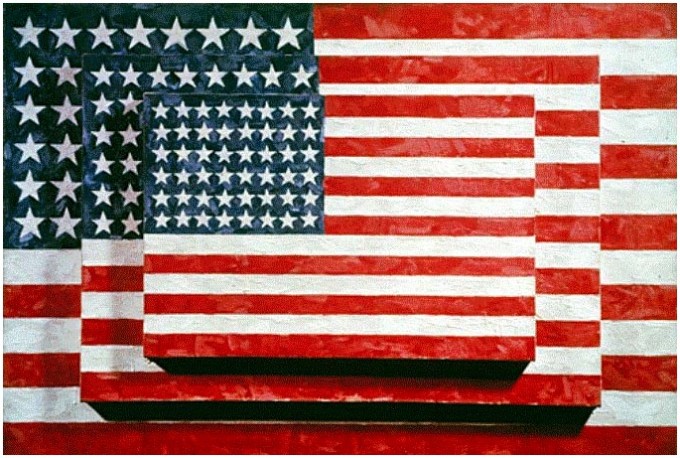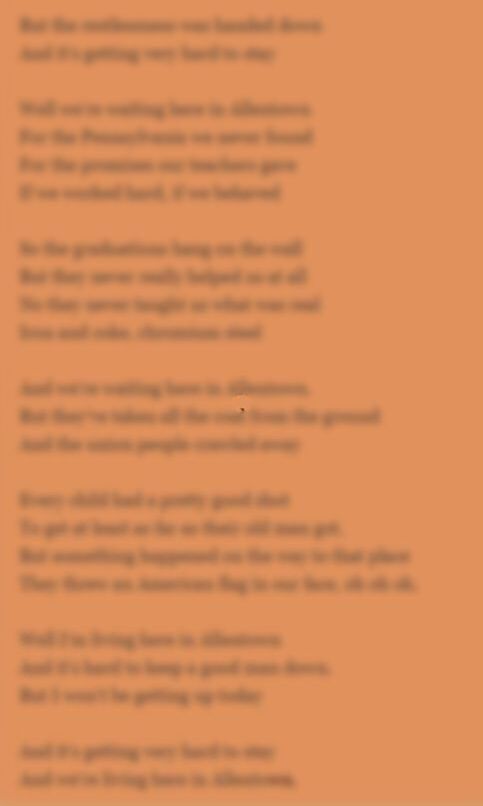|
Allentown
The Nylon Curtain (1982) |
|
So the graduations hang on the wall
But they never really helped us at all No they never taught us what was real Iron and coke, chromium steel "Allentown," the opening song to 1982's The Nylon Curtain, signals that this will be a different kind of album for Billy. The song starts with the sound of a factory whistle and chugs along like a factory assembly line. It features an acoustic guitar, and in the music video Billy is seen playing a guitar like a modern Woody Guthrie or other folk singer. It is an apt portrait as "Allentown" explores the disillusionment of the country during the late 70s and early 80s when the steady factory jobs of the 1950-1970s began to disappear and America lost its status as the world's leading manufacturer.
The price that we each paid on an individual level came in the form of a lost sense, or at a least a diminished sense, of our hopes and dreams. "Something happened on the way to that place" as the graduation diplomas simply hung on the wall and "never really helped us at all." Life was not a 1950's television sitcom like "Leave It To Beaver" or the "Donna Reed Show, rather, it was struggle, conflict, and hardship. As Billy writes "but something happened on the way to that place, they threw an American flag in our face." The nylon curtain of America in the 1970s and early 1980s obscured or veiled our vision of the America we thought we would inherit.
|
Well we're living here in Allentown And they're closing all the factories down Out in Bethlehem they're killing time Filling out forms, standing in line Well our fathers fought the Second World War Spent their weekends on the Jersey Shore Met our mothers at the USO Asked them to dance, danced with them slow And we're living here in Allentown (click here for full lyrics in a separate tab or window)
Vertical Divider
Columbia Records Publicity Photo (1982)
|
The song conveys a weariness brought about by hours of mind-numbing, back-breaking work with no American dream in sight. It is reminiscent of the books of Studs Terkel, like Working, which chronicle the struggles and dashed dreams of the American working class, and not unlike many of the poems of Philip Levine that focus on the human struggle of factory workers and laborers in industrial American such as You Can Have It. The song's focus on workers in Pennsylvania steel mills also reminds me of Michael Cimino's 1978 movie, The Deer Hunter, particularly the first half of the movie albeit it was set in the late 1960s and early 1970s.
Despite its sobering message, "Allentown" was a popular hit, reaching #17 on the US Billboard charts in 1982. People were undoubtedly feeling what Billy was saying in the song, bemoaning the loss of the American dream, or at least the realization that dream was just that, a dream. Billy was a true chronicler of the times.
"Allentown" remains one of Billy's most poignant and socially conscious songs, along with "Goodnight Saigon" and "The Downeaster Alexa." The song also is an interesting complement to his later "Leningrad" which traces the arc of life for people growing up in the Soviet Union during the same period.
* * * * * * * * * * * *
Read this article for background on the song and Billy's early following in the Lehigh Valley area thanks to a few DJs and promoters there. Billy originally wrote the song in the 1970s and called it Levittown, based on where he grew up, but couldn't find the right lyrics for it ("well we're living here in Levittown, and the dirt on the ground is brown"). When the economy went South in the early 1980s and steel factories started closing down, he changed it to "Allentown" after Allentown, Pennsylvania, and found meaningful lyrics. Although the steel mills were primarily in Bethlehem, rather than Allentown, the latter rhymed better. Here is another good article about the song from 1992 by Geoff Gehman in The Morning Call, looking back ten years after the song was released. And here is Billy talking about the song at a Q&A in 2016 (YouTube video).
Forty years after "Allentown" was release, residents of the Lehigh Valley recall and react to the song in this article. The reaction is mostly positive, though some thought the song put Allentown in a negative light.
Forty years after "Allentown" was release, residents of the Lehigh Valley recall and react to the song in this article. The reaction is mostly positive, though some thought the song put Allentown in a negative light.
The song evokes images of an industrialized factory such as depicted in Diego Rivera's "Detroit Industry" mural. In real life, this mural is gigantic and impressive. Click on the image for a larger version. Read about it here.








